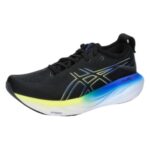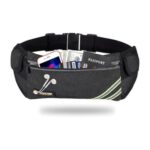Table of Contents
- Introduction: Preparing for cold weather running
- 1. Base Layer: Moisture-wicking fabric close to skin
- 2. Insulating Layer: Retains body heat
- 3. Outer Layer: Windproof, water-resistant shell
- 4. Accessories: Gloves, hat, neck gaiter
- 5. Adjusting Layers: Zipper, ventilation options
- 6. Footwear: Insulated, moisture-wicking socks
- 7. Conclusion: Stay warm and comfortable on runs
Introduction: Preparing for cold weather running
Preparing for cold weather running requires careful consideration of the right clothing layers to ensure comfort and safety during your workout. One essential aspect to keep in mind is the base layer, which should be moisture-wicking to keep sweat away from your skin and prevent you from getting chilled. Choosing a mid-layer that provides insulation while still allowing breathability is key to regulating your body temperature effectively in variable weather conditions.
Additionally, don’t overlook the importance of a windproof and water-resistant outer layer to protect you from harsh elements like wind and rain. Investing in high-quality running gloves, hats, and socks can also make a significant difference in keeping extremities warm during colder temperatures. By strategically layering your clothing and accessories, you’ll not only stay comfortable but also enhance your running performance during the winter months.
1. Base Layer: Moisture-wicking fabric close to skin
Base layers are the unsung heroes of cold-weather running gear. Moisture-wicking fabrics play a crucial role in managing sweat and keeping you comfortable during intense workouts. By pulling moisture away from your skin, these fabrics help regulate body temperature and prevent chafing.
Investing in quality base layers made of moisture-wicking materials is key to a successful winter running regimen. Look for compression-style tops or lightweight long-sleeve shirts that fit snugly against your skin without restricting movement. This layer should feel like a second skin, providing both warmth and flexibility as you hit the pavement on those chilly mornings. Remember, staying dry is just as important as staying warm when braving the elements during your outdoor runs.
2. Insulating Layer: Retains body heat
The insulating layer of your running outfit plays a crucial role in retaining your body heat during cold weather runs. This layer is like your personal cocoon, ensuring that the warmth generated by your body stays close to you, preventing it from dissipating into the chilly air. When choosing an insulating layer, opt for fabrics like merino wool or synthetic materials that are specifically designed to trap heat while remaining breathable.
Remember, the goal of the insulating layer is not just to keep you warm but also to regulate your body temperature efficiently. It should be snug enough to create a barrier against the cold but not so tight that it restricts movement or circulation. Layering effectively is all about finding the right balance between insulation and breathability, allowing you to stay comfortable and focused on your run regardless of the external conditions. By investing in quality insulating gear, you can ensure that your body retains its vital heat throughout your winter workouts, enabling you to push through those challenging miles with ease.
3. Outer Layer: Windproof, water-resistant shell
When it comes to the outer layer of your running outfit, opting for a windproof and water-resistant shell is essential during cold weather. This outer layer acts as a barrier against harsh elements, keeping you dry and protected from strong winds. Look for materials like Gore-Tex or nylon that provide both water resistance and breathability, ensuring that you stay comfortable throughout your run.
Choosing an outer layer with reflective elements can also enhance safety by making you more visible to vehicles and other pedestrians in low-light conditions. Additionally, selecting a lightweight shell will not only ensure that you can easily pack or carry it if needed but also prevent bulkiness that might inhibit your movement while running. Remember, the outer layer is the final shield between you and the external environment, so investing in a high-quality windproof and water-resistant shell is key to a successful cold-weather run.
4. Accessories: Gloves, hat, neck gaiter
When it comes to running in cold weather, the right accessories can make all the difference. Gloves are essential for keeping your hands warm and maintaining dexterity while you run. Look for gloves that are designed for sports, providing both warmth and breathability.
A hat is another key accessory for cold-weather running. Heat escapes from the head, so a good hat will help regulate your body temperature and keep you comfortable throughout your run. Opt for a moisture-wicking material to prevent sweat buildup.
Lastly, don’t forget about a neck gaiter. This versatile accessory can be worn as a neck warmer, headband, or even pulled up to cover your mouth and nose on extra chilly days. It provides an added layer of protection against the elements while still allowing easy breathing during intense workouts.
Accessorizing with gloves, hats, and neck gaiters not only enhances your comfort but also boosts performance by allowing you to focus on your run without being distracted by the cold. Choose high-quality materials that offer both warmth and breathability to strike the perfect balance between comfort and performance in any winter running conditions.
5. Adjusting Layers: Zipper, ventilation options
As the temperatures drop, the ability to adjust your layers becomes essential for staying comfortable during your cold-weather runs. One versatile layering option to consider is clothing with zippers, such as jackets or sweatshirts. Zippers allow you to easily regulate your body temperature by adjusting the level of ventilation and airflow.
Another important aspect to consider when adjusting layers for running in cold weather is ventilation options. Look for clothing with strategic vents or breathable fabrics in key areas like underarms or on the back to help release excess heat and moisture while also providing adequate insulation where needed. By utilizing these ventilation features, you can maintain a comfortable body temperature throughout your run without feeling overheated or chilled.
6. Footwear: Insulated, moisture-wicking socks
When it comes to braving the cold during your winter runs, don’t overlook the importance of insulated, moisture-wicking socks. These unsung heroes of winter running gear play a crucial role in keeping your feet warm and dry, which is essential for maintaining both comfort and performance on chilly days. Insulated socks provide an extra layer of protection against the cold while wicking away sweat to prevent moisture buildup inside your shoes.
Investing in high-quality insulated, moisture-wicking socks is a game-changer for winter running sessions. They not only offer additional warmth but also help prevent blisters and chafing caused by wet feet rubbing against shoes during long runs. Remember that keeping your extremities warm is key to regulating your overall body temperature, so don’t underestimate the impact that cozy socks can have on your cold-weather runs.
7. Conclusion: Stay warm and comfortable on runs
In conclusion, keeping warm and comfortable on runs in cold weather is crucial for both enjoyment and safety. Ensuring the right layering technique can make a significant difference in optimizing your performance while warding off the chill. Remember that quality materials and proper fit are key factors to consider when selecting running clothes.
Apart from layering up, don’t overlook the importance of staying hydrated even in colder temperatures. Your body still sweats during runs, even if you may not feel it as much, so replenishing fluids remains essential. By emphasizing comfort and warmth in your outfit choices, you set yourself up for a more enjoyable experience on those frosty morning or evening jogs. So next time you head out for a run in the cold, prioritize staying snug and cozy to elevate your overall running experience.















